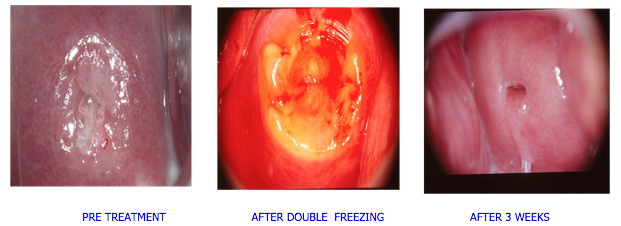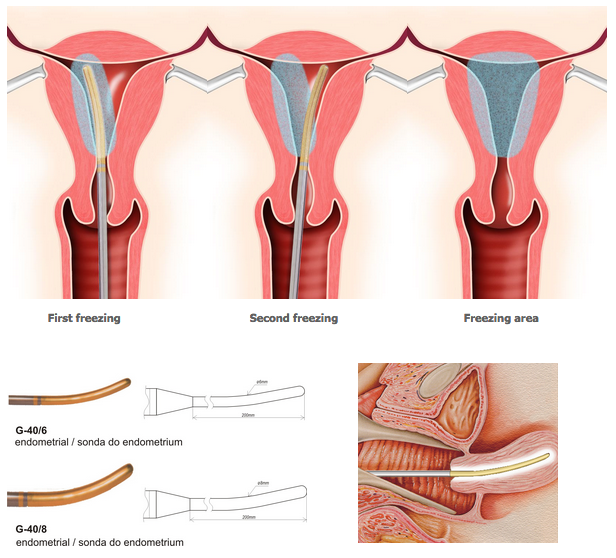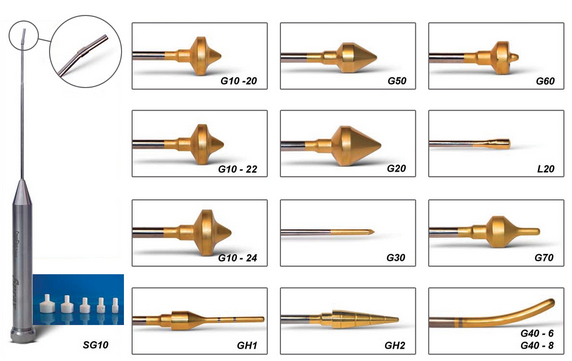
GYNAECOLOGY – CRYO-S Electric
Advantages of cryosurgical Gynaecological treatment
Cryosurgery is a recognised treatment procedure using low temperatures to destroy lesions. Cryo-S units allow freezing of tissue on a measured area and depth.
Thanks to the special shapes of the cryoprobes, full scope of freezing within the area of vagina, fornix, cervix and cavum uteri is possible, as well as within the area of labia, anus and any part of the skin. In Gynaecology, cryosurgery is commonly used in treatment of: ectopia, polypean and papillomatous hyperplasia of the mucous membrane, metaplasia foci with negative onco-histological result. Properly carried out freezing is painless, and leaves no scars after healing. A procedure including two time freezing lasts about 15 minutes. After a few weeks of healing there are no signs of lesions.
Cryosurgical procedures are smokeless, in contrast to photocoagulation, electrocoagulation and laser vvaporisation Extremely high temperatures produce smoke containing biological material, and unpleasant odour. It leads to contamination of the treatment field area. The smoke often contains virus genomes, e.g. HPV, which create danger of iatrogenous infection of airpassages of people staying nearby. Cryosurgery procedures do not cause contamination of the room with vaporised tissue and smoke, so there is no risk of HPV infection.
– Contrary to other methods the zone of tissue necrosis does not increase on the second day after treatment. It is exactly as intended, and consistent with the borders of the frozen area. In case of coagulation methods, burn tissue demarcates deeper than can be seen during the procedure (Laser, LOOP, RF)
– Cryosurgical treatment of cervix pathologies is not associated with the risk of endometriosis! The frozen area remains covered with epithelium, which plays the role of a biological dressing.
– All cryoprobes are autoclavable.
– A wide variety of probes allows for treatments of any section of genital ducts, e.g. in the cervix, which is very difficult if not impossible with the use of photocoagulation or laser.
– Cryosurgical treatment is inexpensive and effective. Satisfaction is guaranteed by the excellent quality state-of-the-art technology.
Procedure…
It is necessary to select the appropriate type of probe suitable to the shape and location of the lesion. Touch the affected place with probe, and activate the device pressing the footswitch. The probe adheres to the tissue lowering its temperature. During about 2 minutes, a margin of frozen tissue is created. It is advisable to achieve freezing depth of 3-4 millimeters. Upon releasing the footswitch the probe warms up within seconds.
Healing…
It lasts a few weeks. The place of freezing remains covered with dead epithelium, which plays the role of natural dressing, and then peels off. After treatment, patient experiences metrorrhea-effusion from among frozen epithelium cells. It is not necessary to use any tablets or globules. However, it is advisable to maintain high personal hygiene, and to take showers instead of baths in a tub. Sexual intercourse during the healing period is inadmissible. If a patient visits other doctors during the period following the treatment, she must inform them of the cryosurgery treatment, otherwise a misdiagnosis is possible.
Final result…
The final result is fully satisfactory. The physiological regeneration of tissue does not leave scars. The sore place becomes healthy, fully elastic. For this reason cryosurgery is permitted in nulligravidas cases. Photo documentation of the changed place before and after cryosurgery is advisable as a very good result may give rise to suspicions that there was no pre-existing illness.
Outcomes

Endometrial cryoablation is considered an innovative technique. We have few data on this technique, and, as of yet, there are published long term results of large, randomized, controlled trials. Based on the results of such randomized, controlled trial shows that endometrial cryoablation compares with transcervicalresection of the endometrium in terms of efficacy, the level of satisfaction and the reoperation rate. It was found that endometrial cryoablation is a very efficient method in women affected by uterine bleeding due to nonmalignant endometrial hyperplasia. Finally, the selection criteria for this procedure include non-obese women, having had menarche at 12 years old or later, having given birth no more than twice, and with endometrial thickness no more than 10 mm.

SPRAY TYPE CRYOPROBES SG 10 – the best cryoprobe dedicated for condylomata acuminata and type of irregular lesion
Developed and patented in Metrum CryoFlex liquifiers system dedicated for Gynaecology can be used with the unique spray type cryoapplicator SG10.



